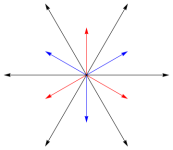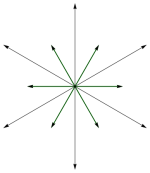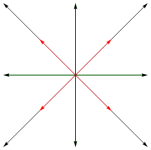Now the 4D case.
A4:
Root elements:
{{0, 1, 0, 0}, {1, 0, 0, 0}, {0, 0, 1, 0}, {0, 0, 0, 1}} -- 1/sqrt(2)*{{0,1,-1,0}, {0,-1,1,0}}
{{1, 0, 0, 0}, {0, 0, 1, 0}, {0, 1, 0, 0}, {0, 0, 0, 1}} -- 1/sqrt(2)*{{0,0,1,-1}, {0,0,-1,1}}
{{1, 0, 0, 0}, {0, 1, 0, 0}, {0, 0, 0, 1}, {0, 0, 1, 0}} -- 1/sqrt(2)*{{1,0,0,-1}, {1,0,0,1}}
{{(-sqrt(5)+5)/8, (-sqrt(5)-3)/8, (-sqrt(5)-3)/8, (sqrt(5)-1)/8}, {-sqrt(5)-3)/8, (-sqrt(5)+5)/8, (-sqrt(5)-3)/8, (sqrt(5)-1)/8}, {((-sqrt(5)-3)/8, (-sqrt(5)-3)/8, (-sqrt(5)+5)/8, (sqrt(5)-1)/8}, {(sqrt(5)-1)/8, (sqrt(5)-1)/8, (sqrt(5)-1)/8, (3*sqrt(5)+1)/8}} -- 1/sqrt(2) * { {(-sqrt(5)+3)/4,(-sqrt(5)-1)/4,(-sqrt(5)-1)/4,(-sqrt(5)-1)/4}, {(-sqrt(5)+3)/4,(sqrt(5)+1)/4,(sqrt(5)+1)/4,(sqrt(5)+1)/4} }
Order: 120
The rotation part matches the rotation part of the icosahedral group, and it can be constructed as {q,inv(q)} for all q in QI. inv(q) is the inverse quaternion ({1,-1,-1,-1}*q)/(q.q). The root elements here are a rotation of that construction.
In general, A

can be constructed as size-n matrices in addition to size-(n+1) matrices. The construction:
Use the root elements of A(n-1) in size-n form, and add a final root element:
For indices i and j in the matrix:
. if i and j < n, then
. . if i == j then (n-2)(n+1) - 2*sqrt(n+1)
. . else -(n+2) - 2*sqrt(n+1)
. else if one of i and j < n then
. . - 2 + (n-2)*sqrt(n+1)
. else
. . (n-2) + 2(n-1)*sqrt(n+1)
all divided by n
2
B4, C4:
Root elements:
{{0, 1, 0, 0}, {1, 0, 0, 0}, {0, 0, 1, 0}, {0, 0, 0, 1}} -- 1/sqrt(2)*{{0,1,-1,0}, {0,-1,1,0}}
{{1, 0, 0, 0}, {0, 0, 1, 0}, {0, 1, 0, 0}, {0, 0, 0, 1}} -- 1/sqrt(2)*{{0,0,1,-1}, {0,0,-1,1}}
{{1, 0, 0, 0}, {0, 1, 0, 0}, {0, 0, 0, 1}, {0, 0, 1, 0}} -- 1/sqrt(2)*{{1,0,0,-1}, {1,0,0,1}}
{{1, 0, 0, 0}, {0, 1, 0, 0}, {0, 0, 1, 0}, {0, 0, 0, -1}} -- {{1,0,0,0}, {1,0,0,0}}
Order: 384
Rotation part: (all dihedral, all dihedral) + (all tetrahedral extra, tetrahedral extra with even number of signs flipped) + (all octahedral, octahedral extra with nonzero in same places xx00 xx00 or in complementary places xx00 00xx))
D4:
Root elements:
{{0, 1, 0, 0}, {1, 0, 0, 0}, {0, 0, 1, 0}, {0, 0, 0, 1}} -- 1/sqrt(2)*{{0,1,-1,0}, {0,-1,1,0}}
{{1, 0, 0, 0}, {0, 0, 1, 0}, {0, 1, 0, 0}, {0, 0, 0, 1}} -- 1/sqrt(2)*{{0,0,1,-1}, {0,0,-1,1}}
{{1, 0, 0, 0}, {0, 1, 0, 0}, {0, 0, 0, 1}, {0, 0, 1, 0}} -- 1/sqrt(2)*{{1,0,0,-1}, {1,0,0,1}}
{{1, 0, 0, 0}, {0, 1, 0, 0}, {0, 0, 0, -1}, {0, 0, -1, 0}} -- 1/sqrt(2)*{{1,0,0,1}, {1,0,0,-1}}
Order: 192
Rotation part: (all dihedral, all dihedral) + (all tetrahedral extra, tetrahedral extra with even number of signs flipped)
F4:
Root elements:
{{0, 1, 0, 0}, {1, 0, 0, 0}, {0, 0, 1, 0}, {0, 0, 0, 1}} -- 1/sqrt(2)*{{0,1,-1,0}, {0,-1,1,0}}
{{1, 0, 0, 0}, {0, 0, 1, 0}, {0, 1, 0, 0}, {0, 0, 0, 1}} -- 1/sqrt(2)*{{0,0,1,-1}, {0,0,-1,1}}
{{1, 0, 0, 0}, {0, 1, 0, 0}, {0, 0, -1, 0}, {0, 0, 0, 1}} -- {{0,0,0,1}, {0,0,0,-1}}
(1/2) * {{1, -1, -1, -1}, {-1, 1, -1, -1}, {-1, -1, 1, -1}, {-1, -1, -1, 1}} -- (1/2) * {{1,1,1,1}, {1,-1,-1,-1}}
Order: 1152
Rotation part: (all tetrahedral, all tetrahedral) + (all octahedral extra, all octahedral extra)
H4:
Root elements:
{{1, 0, 0, 0}, {0, 1, 0, 0}, {0, 0, 1, 0}, {0, 0, 0, -1}} -- {{1,0,0,0},{1,0,0,0}}
(1/2) * {{1, 1, 1, 1}, {1, 1, -1, -1}, {1, -1, 1, -1}, {1, -1, -1, 1}} -- (1/2) * {{1,-1,1,1}, {1,1,-1,-1}}
{{1, 0, 0, 0}, {0, 1, 0, 0}, {0, 0, -1, 0}, {0, 0, 0, 1}} -- {{0,0,0,1},{0,0,0,-1}}
{{1/2, (sqrt(5)-1)/4, (-sqrt(5)-1)/4, 0}, {(sqrt(5)-1)/4, (sqrt(5)+1)/4, 1/2, 0}, {-sqrt(5)-1)/4, 1/2, (-sqrt(5)+1)/4, 0}, {0,0,0,1} -- {{0, 1/2, (-sqrt(5)+1)/4, (sqrt(5)+1)/4}, {0, -1/2, (sqrt(5)-1)/4, (-sqrt(5)-1)/4}}
Order: 14400
Rotation part: (all icosahedral, all icosahedral)
So I've verified the construction of all the finite Coxeter groups except for E6, E7, and E8. I've also verified the quaternion construction of all the 3D and 4D finite Coxeter groups.






